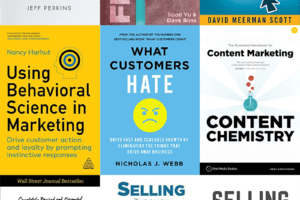Episode 32 of The Verblio Show
Rand Fishkin is one of digital marketing’s original superstars. Through his own content marketing, he’s provided a free world-class education in SEO and digital marketing to everyone who’s watched his fantastic Whiteboard Friday series, read his blog posts, or seen his talks around the world.
And, on top of it all, Rand stands up for what he believes in, speaking out on important issues like monopolies in big tech, diversity on conference stages, feminism… and carbonara.
In this episode, Steve and Rand cover:
- What audience intelligence is, and how Rand’s latest venture SparkToro can help you reach your target buyer more effectively
- How we can democratize the future of content marketing, and how marketers should adapt to the Google/Facebook internet traffic duopoly
- Who Rand is following right now and why
- How to make the perfect carbonara, and the world’s best food & whisky pairing
Guest-at-a-Glance
Name: Rand Fishkin
What he does: Cofounder and CEO of SparkToro. Rand has dedicated his professional life to helping people do better marketing through his blogging, videos, speaking, and his book, Lost and Founder. When Rand’s not working, he’s most likely to be in the company of his partner in marriage and (mostly petty) crime, author Geraldine DeRuiter. If you feed him great pasta or great whisky, he’ll give you the cheat code to rank #1 on Google.
Find Rand on the web: SparkToro | LinkedIn | Twitter
Get smart: “In my career, I have consistently put a lot of energy and effort into things that I can’t prove work but I’m pretty sure one or more of them do work quite well.”
Top Tips from This Episode
Reach your audience directly
Rand has long been helping marketers understand the secrets behind ranking on Google. Today, though, getting organic traffic through the search engine is harder than ever: “Google now ends more than half of all searches with zero clicks to anywhere else,” Rand states. Google and Facebook’s duopoly on web traffic means less traffic for the rest of us.
The solution? Bypass search altogether. “Instead of your having to go to Google and Facebook to reach your audience, you can go directly to the sources of influence that reach them,” Rand explains. This is the idea behind SparkToro, which helps you discover what your audience is reading, watching, and listening to online, and it’s an approach Rand uses himself.
“One of the reasons that I do lots of podcasts and lots of interviews with folks and video series and webinars,” he says, “is because using other people’s platforms has become so relatively valuable when the duopolies have taken so much traffic from everywhere else.”
Harder to measure = easier to win
In an industry governed by metrics, the ability to prove ROI is important—but you’ll miss out if you make it your only consideration. Rand references the hard-to-measure channels that have formed a major piece of his own marketing, like conferences, podcasts, and his Whiteboard Friday video series: “I can see when people consume it, but I have a very difficult time telling whether and when those people ever ended up converting to a paid account.”
So, why did he invest so much in places where he couldn’t prove conversion? “The harder to measure a channel was, the fewer people invested in it, and thus the less competition there was and the easier it was to do uniquely well and to add unique value via those channels,” he explains. Easily measured channels are saturated with marketers looking for hard proof of ROI. If you can be comfortable with uncertainty, you can have other lanes largely to yourself.
Know where your ads are
When you buy paid ads online, you don’t always know where those are going to be displayed. Rand is currently obsessed with the work of thought leader Nandini Jammi, who “holds advertisers, ad platforms, and technology companies’ feet to the fire about supporting, amplifying, and encouraging white supremacy and other very problematic movements online.” As co-founder of Sleeping Giants and Check My Ads, Jammi has brought attention to how much ad spend ends up funding movements that companies wouldn’t want their brand to be associated with.
And social justice isn’t the only reason to keep tabs on your ads. “It’s also an ad spend waste thing and a brand safety thing,” Rand explains. Besides not wanting to fund those movements, you don’t want your brand appearing on their site where people will see it. “And you probably also are not getting value from that,” Rand adds. “It’s not a good use of your ad dollars.”
Episode Highlights
The problem behind Minimum Viable Products
“The problem with the concept of MVP is that it’s been applied far too broadly. In Eric Ries’s book The Lean Startup, he frames MVP as being something that is great for an early stage team with almost no traction, almost no customers, almost no marketing, almost no community, almost no people paying attention, to see if there’s actually a market for this. Like, are a few people interested enough in the problem that we’re solving that they’re willing to use a crappy, hacky solution and try it out?
…Now take that to a company and organization, or even a startup or a person who has a big following with lots of people paying attention. What happens when you launch a crappy version of a product? Generally speaking, your company, your brand, and you get associated with building crappy products and launching crappy products. That is a very, very difficult reputation to shake.”
On SparkToro and audience intelligence
“The basic concept behind SparkToro is we wanted to make software that would help marketers, market researchers, founders, and product builders discover what their audiences read, watch, follow, listen to, and engage with online. …A data driven approach to that has been missing for a long time from our web marketing activities, and SparkToro gets that data by crawling web and social profiles and then aggregating them together.”
The latest overrated trend in marketing?
“I have some slight nervousness that TikTok might be a fad platform in a lot of senses. It’s essentially right now getting a crazy amount of high engagement, and there’s a lot of content creators and producers who put stuff on there. But my suspicion is that because of the temporary nature of the network, the complications of the social and economic relationships between the US and China, and China and the West, and the complications around ownership—that it might be a riskier place to be building your brand.
If I were someone who’s a TikTok creator, I would just be making sure that the things I created were also useful and usable on other platforms and in other places—everything from Instagram to YouTube to my own website—just because I’d want to hedge my bets.”
How SparkToro is helping to restore a healthy capitalist ecosystem
“Facebook and Google’s control of the macroeconomic picture of web marketing and the ability to get traffic on the web is a bad thing. It’s fundamentally a negative that so much concentration of power and influence and capital rests in the hands of these two corporations. If you’re in e-commerce, it’s also Amazon. What I think makes for a healthy capitalist ecosystem—when capitalism and democracy work well together—is when you have lots of small and medium businesses, right? Lots of people with diverse amounts of power and influence in a field—that gives you a truly robust marketplace, that raises everyone’s wealth level and fights against income inequality, which obviously has been a big problem the last 50 years in the U.S. in particular, and around the world.
…To whatever degree we can, I want to level that playing field. So instead of your having to go to Google and Facebook to reach your audience, you can go directly to the sources of influence that reach them. And if you are building influence, you can count on people coming directly to you and saying, ‘I’ll fund your podcast.’ ‘I will come and sponsor this, I’ll pitch you, I’ll work with you. I’ll do a marketing relationship with you. I’ll be a guest on your webinar. Because I know about you.’ Right? ‘I know you exist. I know you reach this group of people.’”
How to make the perfect carbonara
“Do you know some people put cream in their carbonara? It is madness. God, look, there’s a lot of problems in the United States right now. But if you wanna make a great spaghetti carbonara, you cannot put cream in that. The idea is to take the eggs, mostly yolks—I usually do five yolks and one full egg—and then you’re gonna beat them together in a metal bowl with salt and pepper and your parmigiano, and if you want to throw some pecorino in there as well, and a lot of pepper.
And then you’re gonna use basically a double boiler methodology, where you put the metal bowl over the steaming pot of water and you put your fork in there and then you’re gonna stir it up and that will create the right sauce consistency. If it starts to stick at the bottom, pull it. Then dump your pasta and wait until it’s a little cool because if you pour the sauce right in there, it’s gonna scramble and you do not want scrambled eggs. You pour the pasta into where you’ve been cooking your pancetta or your guanciale, if you’re using that. Now, I cannot tell you how good this tastes. …There’s nothing better than a bite of carbonara done well.”
Top quotes
Rand:
[4:30] “Using other people’s platforms has become so relatively valuable when the duopolies have taken so much traffic from everywhere else.”
[7:08] “Applying this MVP methodology to a company that’s achieved some traction or an early stage company that is getting a lot of attention is a terrible idea.”
[20:45] “I worry significantly that the dominance of Facebook and Google has meant this drop-off for the value in creating a publication or community that reaches an audience. In whatever way we can, I want to contribute to the resurgence of that independent publication value.”
[21:22] “I heard someone say that podcasts exist so that men have a socially acceptable way to have meaningful conversations.”
[23:01] “In my opinion, if you get a salt-aged steak, that is perfectly grilled and you pair that with Lagavulin, you are in an extremely happy place.”
[31:59] “I have, in my career, consistently put a lot of energy and effort into things that I can’t prove work, but I’m pretty sure one or more of them do work quite well.”
Learn More
Check out the names Rand references on the show.
- Nandini Jammi is a brand safety advocate keeping ad spend from going to hate speech and bigotry online through her work at Sleeping Giants and Check My Ads.
- Shine Bootcamp is a “professional speaking incubator + accelerator” that provides women with the tools and support necessary to become effective, respected public speakers.
- John D. Saunders is a web designer leading the way for inclusion and diversity in digital through his ventures, Black Illustrations and IllustratorHub.
- Want more help with the perfect carbonara? Watch Kenji’s video for the recipe Rand swears by.



